CL-41G Tebuan
by
Assoc. Professor Ahmad Faisal Alias
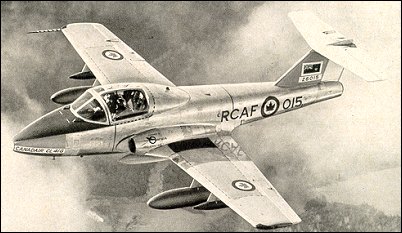 Introduction
Introduction
The introduction of CL-41G Tebuan jet strike aircraft marked the end of the "Non-Fighting Force" concept of the Royal Malaysian Air Force (RMAF) since its formation in 1958. With these CL-41G Tebuans (Tebuan is a Malay word for Wasp), ordered in March 1966 , the Nos. 6 and 9 Squadrons were formed in August 1967 and September 1969, respectively. The Tebuans were the tactical version of the Canadair CL-41 Tutor trainer jets used by the Royal Canadian Air Force (RCAF). The RMAF was the only 'G' version operator in the world -- with 20 aircraft and 30 specially uprated and modified more powerful General Electric J85-J4 turbojet engines, weapons hardpoint stations on the fuselage and wings and zero-level ejection seats. The RMAF managed to keep the aircraft flying for more than 20 years.
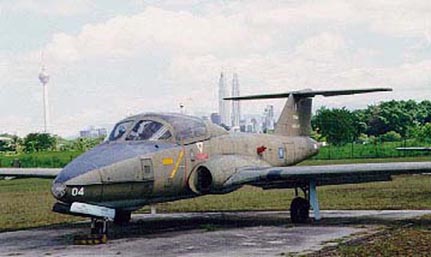
The CL-41G Tebuan is an "all-through" trainer - from initial through advanced stages of pilot training, including tactical and armament training phases. In a permissive environment, the Tebuan also provides a proven significant strike capability. It is a stable weapons platform capabled of delivering several types of ordnance. It's low stalling speed allows pilots to deliver ordnance at pin-point accuracy. The Tebuans were phased out after twenty years of excellent service in June 1986 and replaced by the Italian Aermacchi MB-339A. The other closest aircraft in similar class of the Tebuan is the U.S.-built Cessna A-37 Dragonfly which flew many sorties in the Vietnam Conflict and also served in other U.S. allies air forces in Central and South America (some are reportedly still flying).
 During its operational duties, besides being used as trainer jets the Tebuans
also flew numerous air
strike missions against Communist Terrorists (CTs) camps deep in the Malaysian
jungle. Most of these camps are located near the border with Thailand. Weapons
used during these sorties include 500lb iron bombs, rockets, missiles and minigun pods
in support of artillery and infantry assaults by ground troops from the
Malaysian Armed Forces (Royal Malay Regiments, Royal Rangers Regiments, Army
Commandos, the Royal Malaysian Police Field Force (PFF) and the VAT 69 police field force commandos).
During its operational duties, besides being used as trainer jets the Tebuans
also flew numerous air
strike missions against Communist Terrorists (CTs) camps deep in the Malaysian
jungle. Most of these camps are located near the border with Thailand. Weapons
used during these sorties include 500lb iron bombs, rockets, missiles and minigun pods
in support of artillery and infantry assaults by ground troops from the
Malaysian Armed Forces (Royal Malay Regiments, Royal Rangers Regiments, Army
Commandos, the Royal Malaysian Police Field Force (PFF) and the VAT 69 police field force commandos).
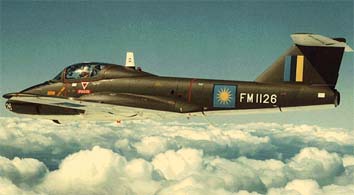 These air strikes were later conducted together
with the RMAF's Northrop F-5Es with the aid of the Allouettes III light
helicopters which served as spotters and forward air controllers (FACs).
Although the thick and triple canopied jungle made spotting and ordnance
penetration difficult, the psychological impact on the CTs was great.
Follow-up by security forces on the ground found several dead CTs in these
camps as well as blood trails leading up to the and across the Thai border.
These air strikes were later conducted together
with the RMAF's Northrop F-5Es with the aid of the Allouettes III light
helicopters which served as spotters and forward air controllers (FACs).
Although the thick and triple canopied jungle made spotting and ordnance
penetration difficult, the psychological impact on the CTs was great.
Follow-up by security forces on the ground found several dead CTs in these
camps as well as blood trails leading up to the and across the Thai border.
The Tebuan served the nation briliantly throughout its counter-insurgency strike/attack and trainer roles. Although none was lost to direct hostile fire, ageing airframes and engines took their toll. Several Tebuans crashed during later routine and training flights, some with the loss of their crew. With more advance avionics and weapons technology, the TUDM's Tebuan was rendered outdated. The remaining Tebuan airframes now sit in storeage or on static display at several RMAF bases around the country and the RMAF museum at the Sungei Besi RMAF base. Several Tebuan were reportedly sold to private ownerships and refurbished to flying status to appear in airshows and was bought and flown by owner, actor John Travolta.
Canadair CL-41 Tutor
Basically, the Tebuan was a Canadair CL-41 Tutor trainer aircraft. Its basic design was started
as a private venture by Canadair with the cooperation of the Canadian government after the
Canadian government accepted Canadair's proposal to develop and test two trainer jet
prototypes for the Royal Canadian Air Force (RCAF). The side-by-side seating arrangement
allows the instructor to easily monitor the trainee during flight and to take over the control
of the aircraft if the situation warrants.
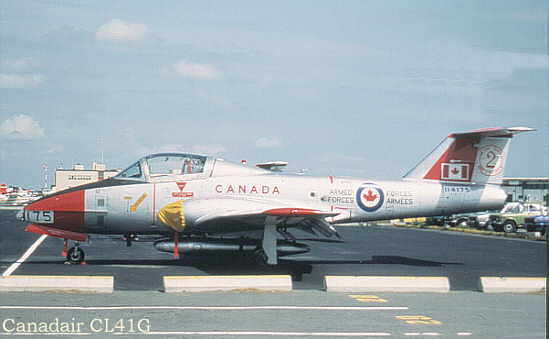 The first prototype, the CL-41A made its maiden flight on 19 January 1960
with Pratt & Whitney Canada JT12 engine. The RCAF ordered 190 CL-41As in early 1962 and
named it 'Tutor'. In May 1962
the Canadian government announced that the Tutors will use the General Elelectric
J85-CAN-40 engines built by the Orenda company. The first production CL-41A flew on
26 November 1962 and the last
unit was produced in November 1966.
The first prototype, the CL-41A made its maiden flight on 19 January 1960
with Pratt & Whitney Canada JT12 engine. The RCAF ordered 190 CL-41As in early 1962 and
named it 'Tutor'. In May 1962
the Canadian government announced that the Tutors will use the General Elelectric
J85-CAN-40 engines built by the Orenda company. The first production CL-41A flew on
26 November 1962 and the last
unit was produced in November 1966.
Virtually all RCAF Tutors were used to train new pilots in which they must have at least 200 hours in the Tutors before they can graduate to fly more advance fighters. 10 Tutors were modified to fly with the RCAF aerobatic team, the Snowbirds.
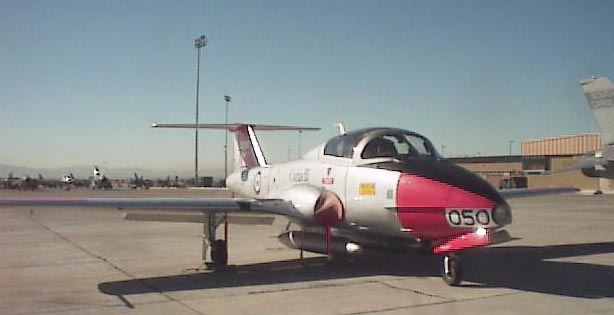 The second prototype produced by Canadair was the electronic systems trainer, the CL-41R.
This aircraft was envisioned as a lead-in trainer for future pilots who will fly the more
advance and sophisticated reconnaisance-attack Lockheed F-104 Starfighter (Canadian
designation CF-104). It was to train these future pilots the sophisticated electronic packages
of the Starfighter. It first flew on
13 July 1962. The aircraft performed well but the CL-41R program was cancelled due to the
difficulty to get a final consensus among the F-104 user countries to warrant the commence of
production.
The second prototype produced by Canadair was the electronic systems trainer, the CL-41R.
This aircraft was envisioned as a lead-in trainer for future pilots who will fly the more
advance and sophisticated reconnaisance-attack Lockheed F-104 Starfighter (Canadian
designation CF-104). It was to train these future pilots the sophisticated electronic packages
of the Starfighter. It first flew on
13 July 1962. The aircraft performed well but the CL-41R program was cancelled due to the
difficulty to get a final consensus among the F-104 user countries to warrant the commence of
production.
Specifications (CL-41G Tebuan):
Engine: 1 x 2,950-pound thrust
General Electric J85-J4 turbojet
Weight: Empty: 5,296 lbs.; Max
Takeoff: 11,288 lbs.
Wing Span: 36ft. 6in.
Length: 32ft.
0in.
Height: 9ft.
.75in
Performance:
Maximum Speed: 480
mph
Ceiling: 42,200
ft.
Range: 1,340 miles
Armament: Up to 4,000 pounds of weapons on underwing and under-fuselage
hardpoints
Number Of CL-41s Built: ~210 (including CL-41Gs)
Created: 12 September 1999
Updated: 23 April 2002